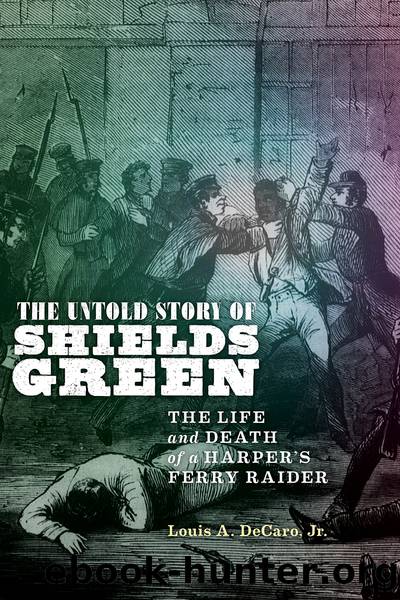The Untold Story of Shields Green by Louis A. DeCaro Jr

Author:Louis A. DeCaro, Jr. [DeCaro, Jr., Louis A.]
Language: eng
Format: epub
Tags: HIS000000 History / General
Publisher: New York University Press
6
Emperor Seen
Image and Identity
Historical enquiry must match the depictive content of the art-work.
Sarah Barber
In early November 1859, while John Brown and his men sat in their jail cells awaiting execution, the Boston sculptor Edward Brackett arrived in Charlestown on a mission to capture the Old Manâs image in a bust. Brackett was financed by one of Brownâs most generous supporters, George Luther Stearns of Medford, Massachusetts, but the task was an unpleasant one because of the hostility of the Virginians toward their prisoners. When Brackett arrived in town, he was cordially greeted by community leaders but soon began to realize that their courtesy belied a determined opposition. Finding himself sent back and forth between the judge and the jailer to no avail, Brackett became increasingly disturbed at getting the runaround by his hosts. When he finally complained to authorities, he was curtly informed that he was suspected of being an abolitionist spy. As coincidence would have it, Brackett found a secret ally in Edward âNedâ House, the undercover New York Daily Tribune journalist with whom he was acquainted. House duly relayed Brackettâs frustrations in the pages of the Tribune, lamenting that it appeared the sculptor would be âobliged to return without accomplishing his object, for it is wholly impossible to satisfy the jealous Virginians that there is not in his visit here a great deal more than meets the eye.â1
Amidst these frustrations, Brackett found fleeting hope when he discovered that a daguerreotype operatorâa man with a cameraâwas accessible, his idea being that he might at least depart from Charlestown with a photograph of John Brown from which to work. However, as House reported, the notion of the camera also âwas met with oppositionâ by leaders in Charlestown. The Tribune journalist noted that the daguerreotype operator was a âtravelingâ photographer, but it may be that he was introduced to Brackett by a local artist named Lewis Graham Dinkle, who may also have had a facility for photography.2
The idea of using a camera perhaps came to Brackett when he learned that ambrotype images were being made of some uniformed militia men near the site of Brownâs incarceration. The extant ambrotypes show cheerful young Virginians in uniform, one of which often was presented as a Civil War photo during the twentieth century.3 According to another researcher, the ambrotypes were made at the instigation of some of the Richmond Grays, a militia unit that included the actor John Wilkes Booth, later the assassin of Abraham Lincoln.4 Outraged by the attack on Harperâs Ferry, Booth had abandoned his performance role at a Richmond theater and went to Charlestown in the guise of a Virginia Gray so that he could participate in the execution of John Brown.5
Despite Brackettâs efforts and the proximity of a camera to the jailhouse, history was deprived of photographic images of Brown and his men in their jail cells, the only reason being the prejudice and resentment of the Virginians. Notwithstanding opposition from officials in town, however, Brackett did finally manage to steal a meeting with Brown.
Download
This site does not store any files on its server. We only index and link to content provided by other sites. Please contact the content providers to delete copyright contents if any and email us, we'll remove relevant links or contents immediately.
Einstein: His Life and Universe by Walter Isaacson(1967)
Finding Freedom: Harry and Meghan and the Making of a Modern Royal Family by Omid Scobie & Carolyn Durand(1355)
Promised Land (9781524763183) by Obama Barack(1318)
Finding Freedom by Omid Scobie(1255)
Compromised by Peter Strzok(1229)
JFK by Fredrik Logevall(1127)
Freedom by Sebastian Junger(814)
The Russia House by John Le Carré(781)
Salford Lads: The Rise and Fall of Paul Massey by Bernard O'Mahoney(735)
The Irish Buddhist by Alicia Turner(720)
Day of the Dead by Mark Roberts(718)
Kremlin Winter by Robert Service(683)
A World Ablaze by Craig Harline(678)
Graveyard (Ed & Lorraine Warren Book 1) by Ed Warren & Lorraine Warren & Robert David Chase(678)
Joe Biden: American Dreamer by Evan Osnos(648)
Flying Tiger by Samson Jack(636)
Melania and Me: The Rise and Fall of My Friendship With the First Lady by Stephanie Winston Wolkoff(616)
100 Things Successful Leaders Do by Nigel Cumberland(614)
The Mission by David W. Brown(594)
